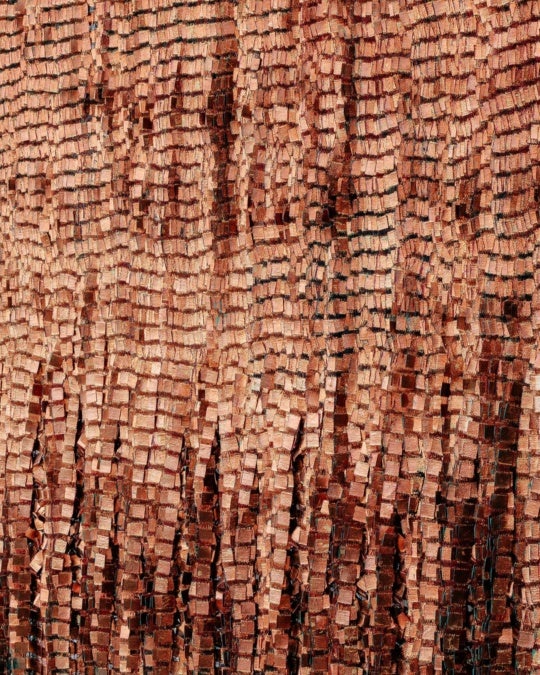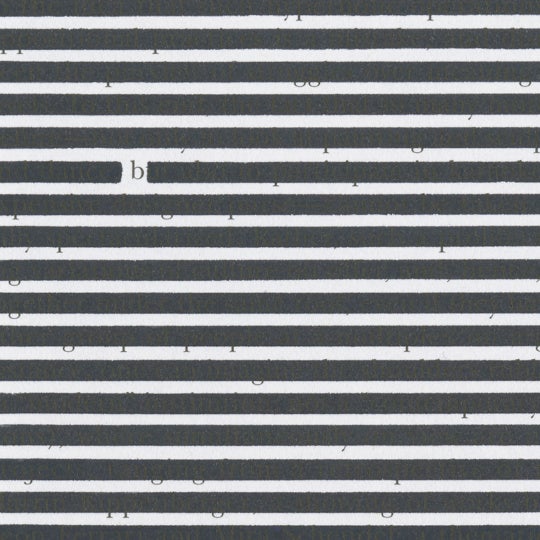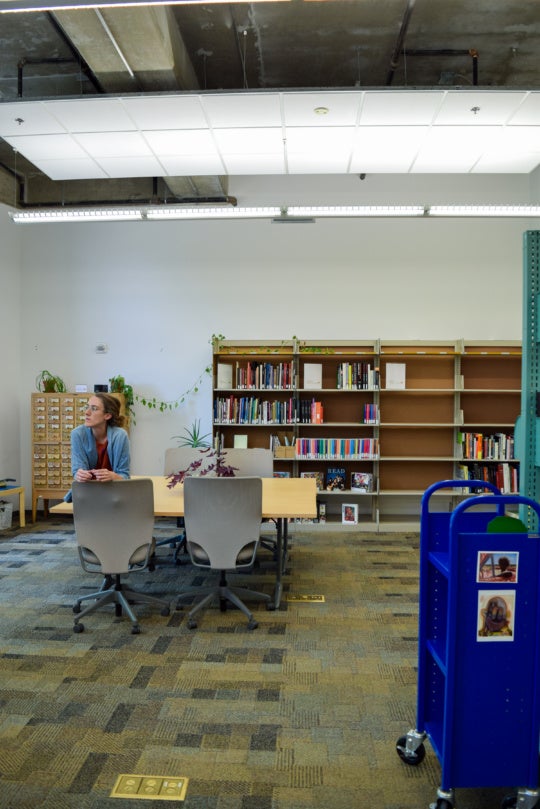
“Weatherwise/Otherwise” is a sprawling group exhibition that addresses the looming threat of climate change. This topical show, curated by art consultant Dot Moye, features twelve artists and is staged in the Dalton Gallery and Center for Sustainability. Located at Agnes Scott College, Dalton contains an appropriately sprawling collection of rooms, and the artworks in the show are just as far-ranging in terms of artistic practice, including textiles, photography, sculpture, drawing, collage and installation. The exhibition theme ties many works together but in some cases fails to span awkward shifts in idiom. The works that hold up the best in this exhibition are the ones that successfully move beyond the theme to embrace other nuances of art-making and universal experience.

Peter Bahouth’s VENT dominates the main gallery. A long white light box stands on supports at eye level, its sides are long panes of glowing white Plexiglas. Eight viewfinders on similar steel supports are directed towards it, four on each side. Peering into each viewer — reminiscent of the View-Masters of the 1960s-80s — one can examine stereoscopic photos of colored smoke rising from clumps of vegetation. The three-dimensional illusion of stereoscopic photography is a little startling, and the act of peering into a viewfinder evokes the intimacy of a peepshow or penny arcade. In this context, the mysterious imagery becomes ominous and illicit. The blue or orange smoke clouds are simultaneously pretty and undoubtedly toxic — an eerie chemical pinup. The vegetation is urban, appearing near building corners or between other manmade structures. Climate change consists mostly of phenomena we can’t see. Bahouth’s 3-D clouds turn this abstract threat into a phantom that floats in front of us.

In an adjacent gallery, a colorful installation by Nathalie Miebach, titled Sibling Rivalry, crawls across the walls. It resembles a large three-dimensional drawing, much like the installations of Sarah Sze or Jane South. Piecemeal elements made of paper, wood, or reed interweave and collect in cryptic masses. Miebach bases her sculptures and installations on weather data, inventing her own formulas to translate chaotic information into shapes, colors and materials. She also generates musical compositions based on her quirky algorithms. Miebach’s sculptures are a fascinating pseudo-science, employing detailed analytic processes that yield artwork instead of empirical conclusions. She posits herself as an obsessive analyst of dubious purpose, changing phenomena into aesthetic experiences.

Another adjacent room is filled with large batiks by Mary Edna Fraser. These dyed tapestries depict coastlines and shores that are being reshaped and redrawn by rising water. Fraser is working with very literal depiction, which is a jarring shift after viewing Bahouth’s and Miebach’s richly evocative and metaphorical pieces. Another strange shift in the exhibition is the inclusion of three artists from Kinngait studios in Cape Dorset, Canada. Ohotaq Mikkigak, Qavavau Manamie, and Ningeokuluk Teevee each have untitled drawings that employ a simple and direct style of depiction. These Inuit artists are all affiliated with Kinngait Studios, and they each have strong connections to regional lore that underpin their practices. The works portray such subjects as polar bears, oil derricks and ice floes that have clear relevance to the exhibition’s theme. That said, with only three drawings in the show the cultural context of the Kinngait artists is difficult to grasp and their work feels anomalous.

Curating is, in large part, an art of understanding the placement of one thing next to another. Art objects inform one another and the act of moving through a space and encountering multiple works is, at its heart, the primary narrative of any exhibition. In this very large exhibition, several parts of this narrative are poorly considered, and disparate pieces are cobbled together by lengthy wall labels that reiterate thematic information. For example, by asking us to consider process and materials as the primary content in Bahouth’s and Miebach’s works, the curator is creating a situation where Fraser’s work is bound to suffer due to its traditional pictorial goals. The exhibition does, however, thematically confront the topic of climate change with impressive breadth.

One pleasant surprise in the exhibition is a group of six works on paper by Karen Reese Tunnell. Tunnell works with paper marbling, a dying process wherein paper is lowered into tubs of water that have had dye dropped onto their surface. The incompatibility of the liquids yields unpredictable and active patterns on the surface of the water, which the paper soaks up. Often thought of as a decorative craft, Tunnell pushes her marbling out of that territory by collaging and painting into it. The resulting works are visually fascinating, highly active and slightly ominous. Autocumulus of a Chaotic Sky contains roiling billows of gray that are cut through with yellow and orange lightning-like streaks. The wavy patterns of the dye and the hard edges of the collage work together to create a sense of movement and graphic strength. Pattern and graphic strength together add a psychedelic edge to Tunnell’s portrayals of weather and chaotic natural phenomena.

The strongest pieces in this exhibition are the ones that go beyond simply illustrating a topic. Art won’t solve climate change on its own, but it can arm us with tools to articulate and reflect upon it. Furthermore, it can create evocative experiences and emotions in ways that scientific fact cannot. The invisible future is inherently ephemeral. “Weatherwise/Otherwise” offers viewers various strategies for imagining it.
Orion Wertz is a painter and graphic novelist living in Columbus, Georgia, where he teaches drawing and painting at Columbus State University.




